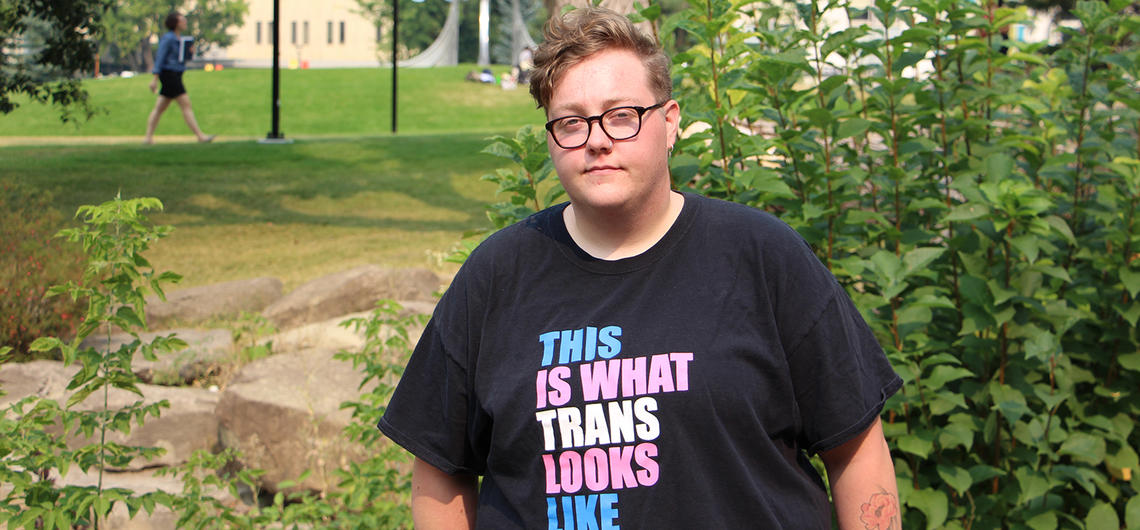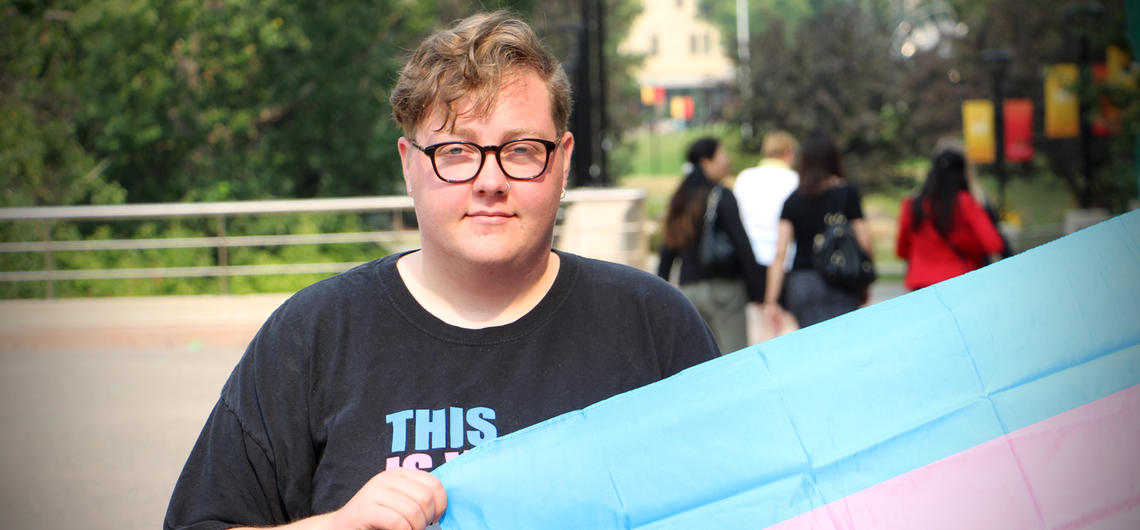Aug. 31, 2017
How do wait times for transgender medical care affect those awaiting treatment?

Paterson studied the impact of wait times for transgender individuals awaiting medical treatment.
Don McSwiney, Faculty of Social Work
A study by University of Calgary Faculty of Social Work undergraduate student Beck Paterson looks at the experience of transgender individuals awaiting medical care in the transition process, where some individuals have to wait several years to undergo treatment.
“Imagine knowing — I mean absolutely knowing — that your eyes are blue,” says Paterson.“Yet, everyone you meet insists your eyes are brown. Now, imagine that the world is separated by eye colour. Imagine that only people with blue eyes are allowed in certain spaces, and people with brown eyes were allowed in others, and no other eye colour exists.
"Everyone insists you belong with the brown-eyed group, but you know you belong in the blue-eyed group. What if your eyes were green? Where would you go then? In a simplified way, this is what gender dysphoria can feel like for a trans person.”
Perhaps not surprisingly, people with dysphoria often experience stress, isolation, anxiety, depression and poor self-esteem. Some studies have shown that transgender individuals have an extremely high rate of suicide attempts, including one large U.S. study that found that 41 per cent of transgender people had attempted suicide, compared to the American average of 1.6 per cent.
Dysphoria treatment is aimed at supporting the individual's preferred gender through approaches such as gender expression and role, and medical interventions including hormone therapy and surgery.
“There has been some research done on the barriers to receiving care,” says Paterson. “We know that there are barriers based on socio-economic status, barriers based on health-care providers’ acceptance of trans identities, and barriers based on the intersections of race and class. My goal was to get a glimpse into how these barriers actually affect people. The more that I talked to people, the more that I found it's just a really messy subject that needs a lot of work.”
Long wait times typify access to medical care for trans individuals
Paterson’s project was funded by a summer Markin Undergraduate Student Research Project in Health and Wellness (USRP), under faculty mentor Jessica Shaw, PhD, RSW.
Shaw says that programs like the Markin USRP are particularly important for professional degrees like social work. "I think it's very important to support undergraduate research," says Shaw, "especially in social work where our students will enter into jobs as practitioners, policy analysts, and social justice activists directly out of their undergraduate degree. We want our students to be informed by real-world experiences, and this project highlights important gaps in how trans people in Calgary are being supported."
The goal of the project was to better understand the experience of individuals in Alberta awaiting transition medical treatment and to identify "bottlenecks" in the delivery of care, with the hope of improving things in the future.
Participants said that in Calgary, long wait times often begin with the “gatekeeping” of services. For example, to access medical care for a transition procedure, people must first get express written approval from a gender-specialist psychiatrist. Since there are only two of them in Calgary, the wait-list for an appointment is 18 to 24 months. In addition, Paterson learned that some physicians are reluctant to help because of moral reasons or a refusal to accept trans identities.
This often leads to an underground information network which can create unanticipated delays, as physicians identified as being “safe” are inundated with people seeking their help.
“There are several lists going around,” says Paterson. “Once the community finds a good doctor everyone says, ‘Go to this doctor! Go to this doctor!’ That actually makes it more complicated because once we find out about somebody, we send everybody there — which creates an additional layer of wait times."

Beck Paterson holds the trans flag; they and their peers will participate in the 2017 Pride parade.
Don McSwiney, Faculty of Social Work
Wait-time stress could be fertile area for future study
Paterson uses the term “we” because they are part of the community and also on several wait-lists, which is one reason they pursued the research question in the first place. They wanted to better understand the experience individuals typically go through, including the psychological stress of waiting.
“I talk to them about what their day-to-day looks like,” says Paterson, “the ways that their dysphoria affects their day-to-day life. For a couple of participants, that meant — on a really surface level — things like wearing a chest binder. Imagine a sports bra three sizes too small and made out of Kevlar or something. Talking about things like that. Like physical appearance — buying clothes that are a little bit too big to hide the curves, or not wearing a certain pair of tights or leggings to make sure that things that they don't want visible are not visible.
“I also ask about the emotional aspect of it. For example, one participant's family wasn't aware yet, and they just kind of told me about the difficulty of being home all the time and hearing the wrong name and the wrong pronouns, but they can't really do anything about that yet. We also talked a little bit about their concept of 'passing,' which means being immediately recognized as the gender you identify with. It’s a complicated term but within milliseconds of meeting somebody, they have decided what gender you are. If someone doesn't necessarily 'pass' well, or people don't recognize that their gender even exists — for the folks who aren't binary transitioning — it's just a kind of day-to-day invalidation, and discomfort with being associated with things that really aren't who they are.”
Paterson is still analyzing the data, drawn from a small sample of people waiting for treatment in Calgary. Even though the study was necessarily small, reflecting a condensed time frame, it was approached with an academic rigour that Paterson hopes will show researchers what a fertile area the subject is for further study.
“My hope,” says Paterson, “is that through this study, other folks in academia might pick up on it, and look into these issues a little bit more, so that the policies and the procedures actually can change in a way that's beneficial to both the health-care provider and the patient.”
Paterson will be part of a large contingent from the Faculty of Social Work participating in this year's Pride parade. Alumni, students, faculty, field instructors and friends of social work are welcome to join us. Check the social work webpage for details.
The Markin USRP invites the university community to the 16th Annual Markin USRP Student Research Symposium on Friday, Sept. 29 at the Rozsa Centre from 1:30-4 p.m. Paterson is one of 40 Markin USRP scholars who will be showcasing their summer 2017 Markin USRP research. Visit the Markin website to learn more.
